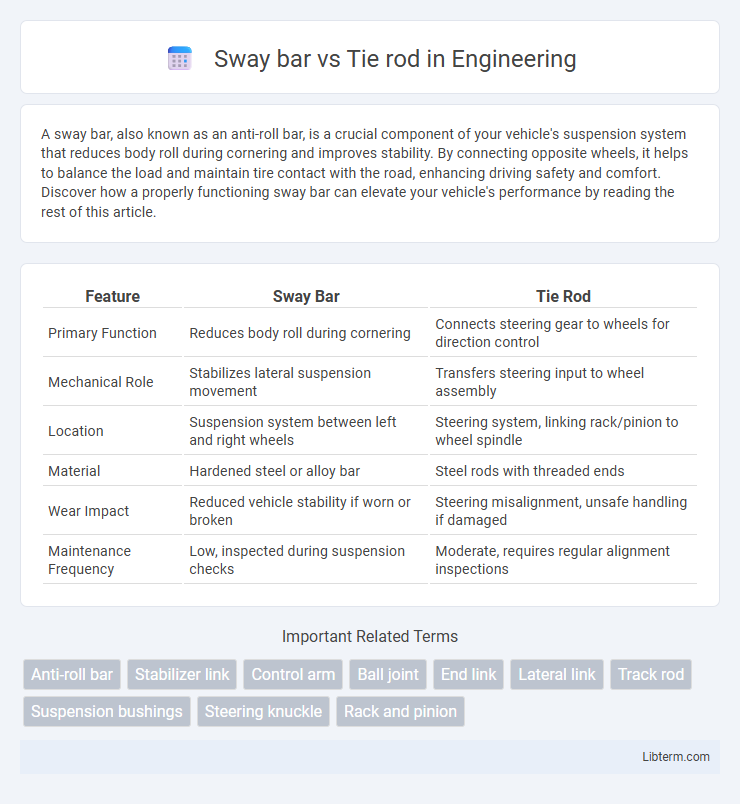A sway bar, also known as an anti-roll bar, is a crucial component of your vehicle's suspension system that reduces body roll during cornering and improves stability. By connecting opposite wheels, it helps to balance the load and maintain tire contact with the road, enhancing driving safety and comfort. Discover how a properly functioning sway bar can elevate your vehicle's performance by reading the rest of this article.
Table of Comparison
| Feature | Sway Bar | Tie Rod |
|---|---|---|
| Primary Function | Reduces body roll during cornering | Connects steering gear to wheels for direction control |
| Mechanical Role | Stabilizes lateral suspension movement | Transfers steering input to wheel assembly |
| Location | Suspension system between left and right wheels | Steering system, linking rack/pinion to wheel spindle |
| Material | Hardened steel or alloy bar | Steel rods with threaded ends |
| Wear Impact | Reduced vehicle stability if worn or broken | Steering misalignment, unsafe handling if damaged |
| Maintenance Frequency | Low, inspected during suspension checks | Moderate, requires regular alignment inspections |
Introduction to Sway Bars and Tie Rods
Sway bars and tie rods are essential components of a vehicle's suspension and steering systems, respectively. Sway bars, also known as anti-roll bars, reduce body roll during cornering by distributing weight more evenly across tires. Tie rods connect the steering rack to the wheel hubs, enabling precise control and directional stability while driving.
What is a Sway Bar?
A sway bar, also known as an anti-roll bar, is a crucial suspension component designed to reduce body roll during cornering by distributing weight more evenly across the vehicle's tires. It connects the left and right suspension systems, enhancing stability and improving handling performance on curves and turns. Unlike tie rods, which primarily control wheel alignment and steering direction, sway bars focus on maintaining balance and minimizing chassis lean for safer driving dynamics.
What is a Tie Rod?
A tie rod is a critical component of the steering system that connects the steering rack to the steering knuckle, enabling precise control of the vehicle's direction. It transmits force from the steering center link or rack gear to the steering knuckle, allowing the wheels to turn accurately. Unlike the sway bar, which reduces body roll during cornering, the tie rod primarily focuses on steering response and alignment.
Key Functions: Sway Bar vs Tie Rod
The sway bar, also known as an anti-roll bar, primarily reduces body roll during cornering by distributing weight evenly across the vehicle's suspension, enhancing stability and handling. The tie rod is a crucial component in the steering system, responsible for transmitting force from the steering rack to the wheels, ensuring precise control and proper wheel alignment. Both components work together to improve vehicle control but serve distinct functions--sway bars focus on suspension stability, while tie rods manage steering accuracy.
Main Differences Between Sway Bars and Tie Rods
Sway bars primarily function to reduce body roll during cornering by connecting opposite wheels through a torsion spring mechanism, enhancing vehicle stability. Tie rods serve as critical components of the steering system, linking the steering rack to the wheel hubs and enabling precise wheel alignment and direction control. While sway bars improve handling by balancing lateral forces, tie rods directly influence steering responsiveness and alignment accuracy.
Signs of Faulty Sway Bar
A faulty sway bar often causes excessive body roll, clunking noises during turns, and uneven tire wear, signaling worn bushings or broken links. Suspension instability and poor handling are common symptoms correlated with a compromised sway bar, reducing vehicle safety and comfort. Unlike tie rods, which primarily affect steering precision, sway bar issues tend to impact overall chassis stability and cornering performance.
Signs of Faulty Tie Rod
A faulty tie rod often manifests through symptoms such as uneven tire wear, loose or shaky steering, and clunking noises when turning. These signs indicate compromised steering stability, increasing the risk of alignment issues and unsafe handling compared to sway bar problems, which primarily affect body roll and cornering comfort. Identifying tie rod faults early can prevent severe drivetrain damage and maintain precise vehicle control.
Sway Bar vs Tie Rod: Impact on Vehicle Handling
Sway bars and tie rods play distinct roles in vehicle handling by enhancing stability and steering precision, respectively. Sway bars reduce body roll during cornering by distributing weight more evenly across the suspension, improving grip and control. Tie rods directly influence steering accuracy by connecting the steering rack to the wheels, ensuring responsive and precise directional changes.
Maintenance and Replacement Tips
Sway bar maintenance requires regular inspection of end links and bushings to prevent excessive body roll and ensure vehicle stability. Tie rod maintenance involves checking for play or wear in the joints, as worn tie rods can lead to steering problems and uneven tire wear. Replace sway bars or tie rods promptly when signs of damage or excessive wear appear to maintain optimal handling and safety.
Choosing the Right Suspension Component
Choosing the right suspension component between sway bars and tie rods depends on their distinct functions; sway bars enhance vehicle stability by reducing body roll during cornering, while tie rods are crucial for steering precision by connecting the steering rack to the wheels. For improved handling and cornering control, upgrading the sway bar is ideal, whereas tie rod replacement is necessary for accurate steering response and alignment. Understanding each part's role ensures optimal suspension performance and vehicle safety.
Sway bar Infographic

 libterm.com
libterm.com